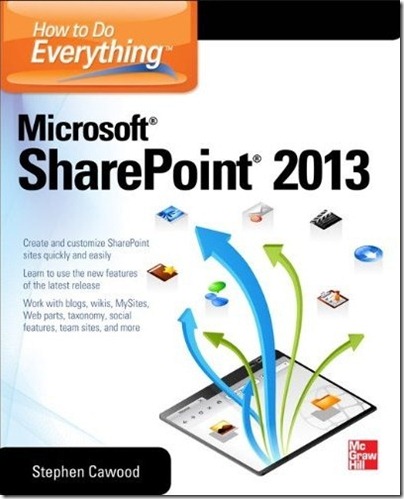Quite regularly, I read this question in a forum, hear it asked at a conference, or someone asks me personally, “How does someone become an MVP?” There is no simple answer, but here’s my stab at it.

First of all, if there is only one thing to remember about the MVP award, it’s this: the Microsoft Most Valuable Professional (MVP) award isn’t a certification.
There are no set criteria or steps that someone can take to become an MVP. As the name implies, it’s an award. However, there are certainly things that you can do to work towards getting a nomination. As I mention below, most people would tell you not to aim for MVP status. It requires significant time and effort, so if you’re not having fun doing community-focused work, it’s probably not worth it.
I think a quick explanation is in order. The MVP award is given out based on specialties. Mine is Microsoft SharePoint Server, so that’s what I’ll be referring to throughout this post, but categories do not have to be products. There are MVPs for development languages (e.g., C#) and there are MVPs for platforms (e.g., ASP.NET or XNA). There are currently about 240 SharePoint MVPs around the world.
“This award is given to exceptional technical community leaders who actively share their high quality, real world expertise with others. We appreciate your outstanding contributions in SharePoint Services technical communities during the past year.”
- Microsoft
In practical terms, this means helping with community-focused resources such as contributing to the SharePoint newsgroups, speaking at conferences, writing about SharePoint and contributing code to CodePlex (an open source site used by the SharePoint community).
The benefits of being an MVP include a TechNet subscription, a subscription to the Microsoft Developer Network (MSDN), access to MVP/product group forums/distribution lists/Yammer networks, software benefits such as access to Office 365 and TechSmith Camtasia Studio, early access to new product builds, and an invitation to the annual MVP Summit. However, the main benefit is being part of the MVP community. I greatly enjoy spending time with other MVPs. If you have a technical question, they’re the best people to ask, and we share common experiences so I often either commiserate or celebrate with them.
The award is given based on nominations--a panel ultimately decides who receives it. There are no published criteria and the members of the panel aren’t disclosed. Also, one key factor is that Microsoft likes to have representation around the world. If there are already a bunch of MVPs in your area—and for your specialty/product—that could make it harder to get the award. However, there is a surprising number of SharePoint MVPs in Toronto, Canada, so this is isn’t a hard rule.

These are the main things that historically have helped with MVP status:
· Speaking at events, conferences and user groups
· Writing original content (e.g., blog posts, articles and books). You must have a blog.
· Developing community apps (usually posted to CodePlex)
· Taking Microsoft certification courses
· Contributing/organizing/starting user groups
· Contributing to the MSDN forums (mainly answering questions).
· Participate in social media and social events (e.g., Twitter, Yammer and social events such as SharePint). You need to get your name out there as a subject matter expert (SME), so the people on the panel have heard your name and seen your work.
I tell people that trying to get the award should not be their focus; there should be value to the things they’re doing independent of trying to become an MVP. However, if I were to set out to get the award today, this is what I would do:
1. Pick a well-defined audience (end-user, dev or admin) and a well-defined sub-topic within SharePoint (or your area of expertise) to focus your efforts. SharePoint is simply too big a topic to do everything.
2. Talk to MVPs and MVP leads (especially your local lead) to get their insight into what would help you get nominated.
3. Meet in person with the current MVP lead for your region. This can help you figure out what’s most important to Microsoft now.
4. Submit presentation proposals to the biggest conferences you can afford to attend, the Microsoft SharePoint Conference plus some user groups and smaller private shows. For the bigger shows, it’s best to submit more than one session since they get way more proposals than they can accept.
5. Make sure you’re regularly posting original content about your expertise. Blog posts, articles, etc.
6. Take some certification courses. Becoming a Certified Master or Certified Architect is a good (but expensive) way to get ‘street cred.’
7. Answer some questions in the MSDN forums, but keep in mind there’s a new certification (Microsoft Community Contributor Award) that’s meant specially for people who do this a lot. I have a notification that goes off every weekday to remind me to go to the SharePoint forums and answer questions.
8. Regularly participate in social media to ensure that the current MVPs in my area and the Microsoft reps know who I am.
Note that somebody has to nominate you. It’s unlikely that you’ll just get an email one day saying you’ve won an MVP award. You need to be talking to people in the community and from Microsoft so that you have a relationship with them and you have some visibility for the good work you’re doing, Note that I’m not suggesting that it’s just a popularity contest; networking and visibility are only helpful if you’re contributing something that has value.
It’s not easy to win the MVP award, so once again, it’s not a good idea to aim to get one—do the things you love to do and if you win the award, it’s a bonus. I feel fortunate to have received three MVP awards and I certainly make good use of the benefits. But I don’t expect that it will be just handed to me… when it comes to renewal… Microsoft will only consider what you’ve done in the last 12 months, so winning the award once doesn’t mean you’ve reached the end of the journey.
Hope that helps keep it clear as mud.





